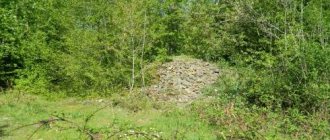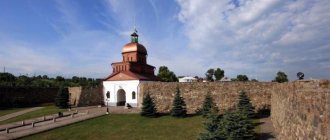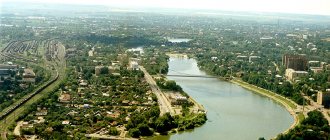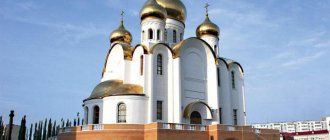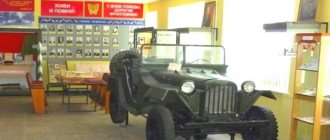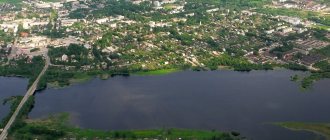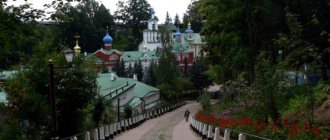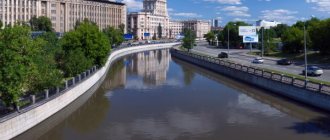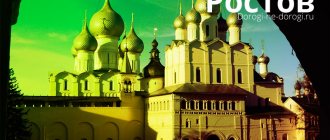Vologda turned out to be one of the most beautiful and pleasant Russian cities we have seen. We went there in August and just for one day. One day is not enough to see all the sights of Vologda.
Vologda is an ancient city, first mentioned in chronicles in 1147, that is, in the same year as Moscow. I have always associated this city with the north. It is located not so far from Moscow, only 450 kilometers. The train from Moscow to Vologda takes 9 hours. We arrived in Vologda at 5 am and went out to the station square. The station looks very good. An anti-aircraft gun stands nearby as a monument to the defenders of the Vologda sky during the war. It would seem that where the Germans are and where Vologda is, but they bombed.
From the station we slowly moved along quiet streets, almost without cars or passers-by, who had not yet woken up, admiring the unusual houses and beautiful churches.
We went to the bank of the Vologda River, from which the city got its name (well, or vice versa - as always, there are many versions).
The Vologda River, despite its consonance, has nothing to do with the Volga. It flows north and belongs to the Northern Dvina basin. The river is small, but there is a pier with a river station, and tourist boats sail along it.
The memorable building of the river station is in a state of protracted restoration, but there is hope that someday it will be completed. We wanted to look at the city from the river by boat, but due to the short duration of our stay in the city, we didn’t have time.
The main attractions of Vologda
- Kremlin Square and Vologda Kremlin
The Vologda Kremlin, which is the main attraction of the city, began to be built by Ivan the Terrible, and is shaped like an irregular quadrangle. From the northern part it is protected by the river of the same name, in the west and southeast it is surrounded by ditches and earthen ramparts.
Kremlin Square with a bell tower and 3 churches, formerly called Cathedral Square, is located between the Kremlin and Cathedral Hill. The architectural and style differences between the buildings are due to the fact that the development of the area lasted for several centuries.
- Revolution square
Bounded by Sovetsky Avenue and Renaissance Square, Revolution Square is considered the central parade ground of the city.
Until October 1918, there were 3 small squares on this site - Aleksandrovskaya, Spasskaya and Sennaya, which were separated by churches and monasteries. The demolished churches of Athanasius of Alexandria and St. Nicholas the Wonderworker significantly expanded the space. The adjacent cramped city streets highlight the enormous size of Revolution Square.
The history of the buildings located on the square is interesting. The Philharmonic Society occupies the premises of the former Assembly of the Nobility. The children's music school previously housed the City Duma.
In the Komsomolsky park adjacent to the site, an “Eternal Flame” was installed in honor of the fallen Vologda residents. Opposite there is a monument to the heroes of the civil war. The pointed white obelisk is shaped like a tooth, which is how it got its name.
- Monument to the 800th anniversary of the city
Not far from the Vologda Kremlin, on the river bank in the ancient part of the city, called the Lazy Platform, a monument dedicated to the 800th anniversary of the city was erected.
For the monument, which has a quadrangular base, the edges of which are decorated in the form of decorative niches in the form of kokoshniks with inserted bronze bas-reliefs, polished northern granite was used. The authors of the monument are sculptors Kontareva.
- Bishop's Court
The bishop's courtyard is called the small Kremlin. For 5 centuries it was the seat of Vologda bishops. Ivan the Terrible planned to turn the Kremlin into his residence in the north, so for security purposes he built a royal palace inside and surrounded it with high walls with watchtowers.
Now the Bishop's Court includes a number of buildings built in the 16th-18th centuries, which are used for holding exhibitions and storing museum funds.
- Oktyabrsky Bridge
Built in 1931, the Oktyabrsky Bridge replaced the wooden Arkhangelsk Bridge, erected at the end of the 19th century. The reinforced concrete arched span bridge is accessible to pedestrians and cars. The middle arched part of the bridge allows river boats to pass under it.
Kirovsky Square
At the intersection of the central streets of Vologda, Lenin and Galkinskaya, there is a spacious park with wide asphalt paths, beautiful lawns, spectacular lanterns, and tall trees.
In the park there are comfortable benches on which residents and guests of the city relax, students of the Technical University located nearby leaf through notes, and students of the oldest gymnasium No. 1, which is also located nearby, run around.
In honor of the celebration of the 50th anniversary of the Komsomol, an obelisk of Glory . The names of the Heroes of the Soviet Union of the residents of Vologda are immortalized on the monument . The square is shaped like a triangle. It is protected from noisy streets by plantings of spruce, birch, linden, and lilac bushes.
Architectural landmarks
The sights of Vologda are distinguished by interesting architectural features.
- House of Peter I
Peter the Great, who visited Vologda 5 times, constantly stayed in a one-story stone building on the high bank of the river. This small building, which became the first Vologda museum, was previously the property of the widow Goutman. Here you can see Dutch ovens with tiles from the 17th century, personal belongings of the emperor.
The museum is located on Sovetsky Prospekt and is open from Wednesday to Sunday from 10 to 17.30. The entrance ticket costs 80 rubles; a discounted ticket is provided for schoolchildren and pensioners.
- Shalamovsky house
Located near the St. Sophia Cathedral, a 2-story building built in the 18th century attracts tourists interested in the literary work of V. Shalamov. The writer’s family lived in this house, which belonged to the Vologda clergy. Now it is a cultural center that unites the Shalamov House and the Art Gallery.
The museum is located on S. Orlova Street, which can be reached from the railway and bus stations by buses 7, 29, 30, 38 (exit at Torgovaya Ploshchad).
The house is open daily, except Monday and Tuesday from 10 to 18 hours. Ticket costs 120 rubles, excursion service 140 rubles. Disadvantaged categories of the population can visit the museum for free.
- House of Puzan-Puzyrevsky
The nobleman Puzan-Puzyrevsky, from where the name of the museum came, actually lived in Vologda in a beautiful 2-story mansion with a superstructure that belonged to him.
The house is interesting because in 1918, evacuated attorneys from embassies, consulates and missions lived there for 5 months, as well as the presence of the ghost of the former owner, who is fighting the careless tenants of the building.
You can get to Herzen Street, which was previously called Ekaterino-Dvoryanskaya, where the interesting house is located, by trolleybus No. 2 or by buses 6, 9, 12, 15, 17, 18, 25, 27, 35, 36, 37, 43, 45, 48, 49 (stop "Galkinskaya").
- House of Zasetskys
Being the oldest surviving wooden building in the city, the Zasetsky House, built in the classicist style, is located on Leningradskaya Street.
The building is included in the list of heritage of wooden architecture of the Vologda region.
The Zasetskys are an old noble family, one of whose representatives became the first local historian and author of a book about Vologda, and also collected a large library and a collection of ancient exhibits of the region. You can get there by bus 7, 8, 11, 27, 29, 32 (exit at the Leningradskaya stop).
- House of merchant Samarin
The only surviving urban wooden estate, built at the beginning of the 20th century, bears the name of the Vologda merchant Samarin.
The museum halls display interesting exhibitions:
- apartment in an old apartment building;
- a pre-revolutionary school, telling about the life of schoolchildren of past centuries;
- a tea salon, where tourists are introduced to the traditions of drinking tea;
- a photo salon where you can get acquainted with photographs of past years, as well as take a photo as a souvenir against the backdrop of the interior of past years in costumes of the past;
- Russian feast, introducing table and culinary traditions.
The museum is located on Sovetsky Prospekt, 16a. You can visit 5 days a week (Wednesday - Sunday) from 10 a.m. to 5 p.m.
- Semenkovo
In the architectural and ethnographic museum "Semenkovo", located 12 km from Vologda, on the banks of the river of the same name, in the monuments of Russian wooden architecture of the 19th-20th centuries. the traditions of life in the Russian village are presented.
In addition to traditional excursions, Semenkovo offers thematic interactive programs that introduce tourists to the traditions and life of the village. The most popular programs are those telling about one day in village life, as well as events from the “Solstice” cycle, timed to coincide with the holidays of the national calendar.
In the museum, upon prior request, folk craftsmen regularly conduct master classes on birch bark weaving, pottery, traditional painting and embroidery, and making folk dolls.
From May to October, the museum is open every day except Mondays from 10 a.m. to 7 p.m., the rest of the time from 10 a.m. to 5 p.m., with Mondays and Tuesdays closed. To receive excursion services, you must make an appointment in advance by calling (8172) 21‑01-90. You can get to the village of Semenkovo along Kirillovskoye Highway.
- Brianchaninovs' estate
Stone manor built in the 19th century. according to the classical traditions of estate construction, it is located near the city, in the village of Pokrovskoye. The beauty of the house is given by the slender proportions, rich plasticity of the facade, and elegant decor.
In the manor park, which runs down the hill in terraces, you can admire examples of landscape art from the 18th-19th centuries. You can get to the estate by bus 217, departing from the bus station three times a day (9, 14, 16) from Wednesday to Sunday.
Due to the small size of the noble house, which accommodates no more than 40 people, tourists need to make an appointment in advance by phone.
Strasbourg Square
In the area of the Vologda Flax Mill, along Moskovskaya Street, between Tekstilshchikov and Dzerzhinsky streets, Strasbourg Square stretches.
The square begins near the bus stop " Elma's store ". The square received this name in honor of Vologda’s sister city, Strasbourg in France. The capital of European parliamentarism also has a “Vologda Square”.
The paths in the park are paved with paving slabs and there are many comfortable benches for relaxing. The most visited place is the equipped children's corner, where there are always a lot of children. The park has a large area of green lawns, bordered by trees and shrubs. The square is well lit in the evening.
Religious sites
On the territory of Vologda there are holy places, temples and monasteries that attract tourists and pilgrims from all over the world.
- Saint Sophia Cathedral
The Orthodox St. Sophia Cathedral, located on Kremlin Square, was built on the model of the Assumption Church in Moscow. Being the oldest stone structure in the city, it has been well preserved to this day. The cathedral, built according to the classic cross-domed plan, has the shape of a rectangle with 5 attached chapters, topped with onion domes.
The wall paintings and frescoes that make up the interior decoration of the temple were made in the 2nd half of the 17th century. The greatest interest of visitors is the unique fresco with a picture of the Last Judgment.
Currently, the cathedral is part of the Vologda State Museum-Reserve and is available to visitors in the summer. Periodically, services are held here on some church holidays.
- Spaso-Prilutsky Monastery
As part of the Spaso-Prilutsky Dimitriev Orthodox monastery, which is a complex of architectural monuments of the 16th-18th centuries, there is the Spassky Cathedral and the oldest wooden tent-roofed Church of the Assumption.
The monastery was founded by Dmitry Prilutsky, a student of Sergius of Radonezh. The reason for the increased attention to the monastery on the part of Orthodox believers is the relics of its founder resting in one of the cathedrals.
- Kazan Church
The functioning Orthodox Kazan Church, located on Torgovaya Square, is an architectural monument of national significance. The church is cubic in shape, has 1 dome, built at the end of the 18th century. on the site of a wooden one, founded by Ivan the Terrible in the middle of the 16th century.
The temple was painted by painters from the Spaso-Prilutsky Monastery. Now most of the painting has been lost, so the surviving fragments are of great value.
The church is open to believers and tourists; divine services are held regularly, the current schedule of which can be found on social networks (VKontakte group).
- Temple of Helen and Constantine
The Church of the Holy Equal-to-the-Apostles Kings Constantine and Helen, located on Victory Avenue, is an example of a picturesque trend in ancient Russian architecture, widespread in the second half of the 17th century.
In the cold upper floor of the temple, services are held in the summer, and in cold weather, services are held on the first warm floor. The temple is active, the schedule of services can be found on the temple website. You can get to the place by buses 7, 8, 27, 29, 32, 37 (stop “Proletarskaya”).
- Temple of John Chrysostom
Located within walking distance from St. Sophia Cathedral, the Church of St. John Chrysostom is designed in a classical style. At the base there is a five-domed quadrangle, to which galleries adjoin. The unique bell tower, attached to the north-west, attracts the eye with a beautiful octagonal belfry, which is completed by an elegant pyramidal tent.
The shrine kept in the temple - a particle of the relics of St. Alexander of Svirsky - attracts believers and tourists. Currently, work is underway to restore the temple, but services are held every Sunday at 2 p.m. You can get to the temple by crossing the river from the St. Sophia Cathedral along the pedestrian Red Bridge.
Saint Sophia Cathedral
St. Sophia Cathedral (summer temple) together with the Kremlin and the bell tower is the calling card of Vologda. Photographs, paintings, magnets, boxes, even curtains and lace with their images from different angles are the most popular souvenir products.
The opposite bank of the river is the favorite spot of all Vologda photographers.
The temple was painted from floor to ceiling in 1687–1688. The frescoes have survived to this day. Their restoration and replacement of the iconostasis was carried out in 1744 in the Baroque style, so the Orthodox church has icons of non-traditional writing, very similar to Catholic ones. Among the many images, a unique fresco depicting the Last Judgment stands out. Its area is about 400 square meters.
Museums and theaters
- Lace Museum
Vologda, whose attractions are located on the Kremlin Square, constantly attracts tourists. At the Lace Museum you can get acquainted with the traditional artistic craft of this region, get information about the development of lace making in Europe in the 19th-21st centuries, and admire the original products of specialists from the Snezhinka association.
You can get to the museum by buses 4, 7, 8, 11, 14, 16, 22, 27, 29, 30, exit at the stop "). The museum is open 5 days a week from Wednesday to Sunday from 10 to 17 hours. The entrance ticket costs 100 rubles; for schoolchildren, students, and pensioners there is a discounted ticket for 50 rubles.
- Museum "World of Forgotten Things"
Exhibitions of the museum “The World of Forgotten Things”, located in the restored interiors of a 19th century mansion. immerse visitors in the atmosphere of that time.
The museum is located on Leningradskaya Street, you can get to it by buses 7, 8, 11, 16, 22, 27, 29, 32, 37, 37E, 42 (exit at the Leningradskaya stop). You can visit the museum from Wednesday to Sunday from 10 a.m. to 5 p.m. Information on ticket prices should be checked on the official museum website.
- Museum "Vologda Link"
In the “Vologda Link” museum, located on the street. M. Ulyanova, 33, you can get acquainted with the history of the personalities of political prisoners who served their sentences in these places. The exhibition is housed in a wooden house, in which at the beginning of the 20th century. I.V. Stalin lived as a political settler.
The location of the museum is convenient, within walking distance from the Kremlin Square. The establishment is open from Tuesday to Saturday from 10 to 17 hours. The ticket price is 80 rubles, for schoolchildren, students, and pensioners there is a 50% discount.
- Museum "Literature. Art. Century XX"
There are 4 literary museums in Vologda. One of them, dedicated to literature and art of the 20th century, is located on the street. Herzen, 36. In the museum you can get acquainted with the life and work of the lyrical poet N. Rubtsov, who wrote about the nature of the North, and the composer V. Gavrilin, whose works can be heard in the halls of the museum. The presented books, photographs, and documents reflect the era of that time.
You can view the exhibition by taking buses 6, 37, 40 or trolleybus 5 from the station to the stop “ul. Herzen" or from the Vologda Kremlin by bus 27 to the "Galkinskaya" stop. Ticket prices and opening hours can be found on the museum’s website.
- Vologda Drama Theater
Vologda Drama Theater, which in the middle of the 19th century. founded by entrepreneur B. Solovyov, offers performances by classics and contemporaries on three stages - main, small and chamber. The theater is located on Sovetsky Prospect; detailed information about the repertoire and tickets can be obtained by calling 8172 72‑61-66 or on the theater website.
- Gallery "Red Bridge"
The art gallery of contemporary art "Red Bridge" presents works of artists of past generations working in the style of realism, symbolism, as well as works of modern authors who use original ways of expressing their own thoughts and feelings.
The gallery is located near the bridge of the same name, on the 6th Army Embankment, and is open daily, except Fridays, from 10 a.m. to 6 p.m. The entrance ticket for adults costs 50 rubles, for children, students and pensioners 35 rubles. On Thursday you can visit the museum for free.
Sculptures and monuments
- Monument to the letter "O"
On the 865th birthday of the city, the square near Cathedral Hill was decorated with an original monument to the letter “O”, which reflects the peculiarities of the dialect of local residents. A popular urban metal sculpture 2.5 m high immortalizes the favorite letter of Vologda residents, found in most local names.
Turning into the park after leaving the Vologda Kremlin, you can easily find this monument.
- Monument to K. N. Batyushkov
On the Kremlin Square of Vologda there is an original monument to the famous poet K. Batyushkov, created by sculptor V. Klykov.
The 4 figures included in the composition reflect the 2 essences of K. Batyushkov - a warrior (the figure of Athena) and a poet (the figure of the Muse). Tourists and locals are advised to rub the Muse's big toe to attract good luck. Vologda residents love this sculpture and ironically call it a horse monument.
- Monument to the electric lantern
To mark the 100th anniversary of equipping the city with electric energy, a monument to the first electric lamp was erected on Prechistenskaya embankment. An exact copy of a lamppost from the early 20th century. is located near the pedestrian bridge, not far from the city's puppet theater.
Architect E. Nikitina, in order to add charm and color to the sculpture, supplemented the sculpture with the figure of a dog relieving itself on a pillar. Witty city residents call the composition “Monument to the Pissing Dog.”
- Monument to Nikolai Rubtsov
The sculpture of the Russian poet N. Rubtsov by A. M. Shebunin is installed in Petrovsky Square, which stretches along Sovetsky Prospekt. The figure of Rubtsov is made in full height, and the poet’s gaze, addressed to his descendants, is filled with romance.
Theater Square
The square is located along Oktyabrskaya Street and starts from Batyushkova Street, behind the Theater of the Young Spectator (Youth Theater).
Theater Square or Theater Boulevard has always been famous for its well-groomed appearance, incredibly beautiful flower beds, poetic shady alleys, beautiful lanterns, secluded benches in the thickets of lilac bushes. There are always a lot of young people, older people, and mothers with children walking here.
In the park it is nice to sit in the fresh air while waiting for the start of the performance at the regional theater of the Young Spectator, next to which there is a green area. It stretches along Oktyabrskaya Street from Batyushkova Street to the theater building.
Interesting and unusual places
- Vologda, whose sights can be found at every step, is famous for its open forged door installed at the intersection of several streets - Burmaginy, Leningradskaya, Mayakovsky. Any wish will come true if, after passing through it, you knock on the knocker that replaces the door handle.
- On Blagoveshchenskaya Street near 24 there is an unusual sculpture - a bench of reconciliation. Consisting of 2 inclined marble slabs, the bench does not allow you to stay on the edge; it necessarily rolls towards the center. Getting closer to each other is so necessary for those who are in a quarrel.
The fitting bench is a landmark in Vologda who is in a quarrel - Installed on Zosimovskaya street. the artifact helps improve your financial condition. By placing your hand on it, you can recharge yourself with the world energy of money.
- You can admire the carved fence, sung by the Belarusian ensemble “Pesnyary”, on Blagoveshchenskaya Street, 34
- On Pushkinskaya Street there are bronze doves that coo on the lovers' bench.
Kovyrinsky Park
It is located near Regional Hospital No. 1, adjacent to Shchetinina Street in the area between Gagarin and Lechebnaya streets.
Vologda residents lovingly call this green corner of the city “Kovyrin Garden”. This is a former manorial estate, once famous for its beautiful garden and park ensemble.
For a long time, the beautiful park was desolate, but now it is being actively improved. Without disturbing the unique landscape, sidewalk paths were laid, a children's playground was built, lawns were tidied up, and benches were installed. The park ponds were dredged and cleaned using heavy equipment. There is now an observation deck on the Big Pond.
Pensioners relax under old spreading oaks and elms, mothers with children walk, young people spend time on sports fields. The old park has found a second youth to the delight of Vologda residents.
Where to go with a child in Vologda
- With children it is interesting to visit the Park of Culture and Recreation of Labor Veterans, located on the street. Nekrasov and the Park in front of the House of Culture of the Bearing Plant, located on Leningradskaya Street, where you can go on rides or rent equipment.
| Ferris wheel | 50 rub |
| Colliding cars | |
| Train on the railway | |
| Carousels | |
| Bicycle rental, quad biking, catamaran riding | From 100 rub. |
| Theatrical performance with the participation of fairy-tale characters | 150 rub. |
| Electric car rental for children under 7 years old | 100 rub for 7 minutes |
| Children's town with slides and labyrinths | for free |
In the Palace of Culture there is a dino amusement park “The Lost World”, where you can:
- meet dinosaurs;
- play in the interactive sandbox;
- conquer the climbing wall;
- go through the mesh maze;
- visit the 3-D room;
- take part in educational games.
The cost of a 1-hour visit for a child is 250 rubles, for children under 3 years of age admission is free, for an accompanying adult - 150 rubles. Preferential categories of citizens can take advantage of a discount of 50 rubles.
- The Botanical Garden is open daily from 9 a.m. to 5 p.m., a full ticket costs 250 rubles, a child ticket costs 150 rubles. Located in Ershovsky Lane.
- The Einstein Museum of Entertaining Sciences, located on Leningradskaya Street, operates in the format of learning through play, and a playground is open. The exhibits in the museum can be touched and tested in action. A child ticket costs 350 rubles, an adult 150 rubles, 1 hour on the playground 200 rubles.
What to see in Vologda in 1 day
Vologda, whose attractions are concentrated in the center, can initially be viewed from the Lazy Platform or Cathedral Hill, where significant objects of the Vologda Kremlin are clearly visible.
Near the Kremlin Square there are iconic places of the city:
- Lace Museum;
- House of V. Shalamov;
- Resurrection Cathedral;
- Nevsky Temple;
- monuments to Batyushkov, the letter “O”.
Next you can explore the Church of the Intercession, which is an architectural monument. On the opposite side of the river you can see the 6th Army Embankment with the Sretenskaya Church located on it.
From Kremlin Square it is easy to reach historical churches - the Church of Elijah the Prophet and the Church of Varlaam Khutynsky. Here you can also see the exhibitions of the Museum of Forgotten Things, located in a merchant's mansion.
Square on Oktyabrskaya Street
OLYMPUS DIGITAL CAMERAThe square is located in the city center. It starts from the monument to the USSR pilot-cosmonaut P.I. Belyaev, installed on Maltsev Street opposite the Vologda Regional Theater for Young Spectators. A wide strip runs along Oktyabrskaya Street to the 30th Anniversary of October Park, which stretches along Leningradskaya Street.
The square is decorated with flower beds, green lawns, and there are group and row plantings of trees of different species. Among them were spruce, maple, elm, apple, birch, and many shrubs.
It's a good place to relax on the comfortable benches in their thick shade.
In the park there is a monument to the “ Militia Belfry ” and an obelisk to internationalist soldiers .
There are always a lot of children walking on the wide, renovated paths. Parents take them to the playground, to the interesting sculptures “Frog and Flower”, “Lizard on a Turtle”. The square is well lit at any time of the day.
What to see in Vologda in 2-3 days
The first day can be devoted to exploring the central part of the city.
The next day, continue the tour by visiting the museum, located in the building of the Noble Assembly at the intersection of Pushkin and Lermontov streets and the existing stone Church of John the Baptist, located in the Pushkin Garden. Nearby are the A. Komelsky Chapel and the Vologda Link Museum, which are also significant places in the city. On Sovetsky Prospekt you can visit Petrovsky House. Another possible route is a walk along the Red Bridge and inspection of temples and architectural monuments on the opposite bank.
On the third day, it is better to see distant objects - for example, the northern outskirts of Vologda with the Spaso-Prilutsky Monastery located there. In summer you can get there by pleasure boat. It is good to devote a whole day to visiting the Semenkovo architectural and ethnographic museum.
Osanovskaya Grove Park
An ancient park adjoins the large residential area "Byvalovo" in the southern part of the city.
The shady, cozy Osanovskaya Grove is popular not only among residents of the microdistrict; townspeople come here with entire families and cheerful groups to relax surrounded by nature.
The park captivates with its naturalness, the abundance of large trees - Canadian and silver poplars, birches, lindens, elms. The park interior is decorated with willow and rowan trees. There are no benches, landscaped lawns, or flower beds, but the special charm and spirit of the Osanovskaya Grove attracts Vologda residents to its lovely, “homey” corners.
What to bring from Vologda
You can bring as souvenirs:
- Delicate hand-woven bobbin lace items, including the recently popular lace-patterned T-shirts.
- Fragrant, with a slight nutty flavor, Vologda oil.
- Silver tableware and jewelry made using the blackening method.
- Products from Vologda birch bark.
- Boxes, panels, jewelry with enamel.
- Pottery products made from local red clay.
- Vologda felt boots.
- Linen tablecloths, towels, napkins, socks.
- Christmas decorations.
- Crafts from their juniper.
- Dishes made from Semikarakor faience.
The sights of Vologda, captured in photographs, and the local souvenirs brought will leave the beauty of this northern region in your memory for a long time.
Author: Marina K.
Article design: Mila Friedan
